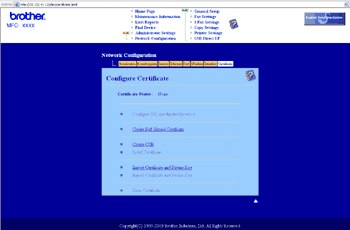The Brother print server allows you to use SSL/TLS communication by configuring a certificate and corresponding private key. This print server supports two certification methods. A self-signed certificate and a certificate that is issued by a CA (Certificate Authority).
| • | Using self-signed certificate |
| • | Using a certificate from a CA There are two methods for installing a certificate from a CA. If you already have a CA or if you want to use a certificate from an outside trusted CA: |

Note
| • | If you are going to use SSL/TLS communication, we recommend that you contact your system administrator before using. |
| • | This print server stores only one pair of a certificate and a private key that you installed or previously imported. This printer overwrites the certificate and the private key if you install a new one. |
| • | When you reset the print server back to its default factory settings, the certificate and the private key that are installed will be deleted. If you want to keep the same certificate and the private key after resetting the print server, export them before resetting and re-install them. (See How to export the certificate and private key.) |
This feature can be configured using Web Based Management (web browser) only. Follow these steps to access the configure certificate page using Web Based Management.
| 1 | Start your web browser. |
| 2 | Type “http://printer’s IP address/” into your browser (where “printer’s IP address” is the printer’s IP address or the node name). | • | For example: http://192.168.1.2/ |
 Note | • | If you have edited the hosts file on your computer or are using a Domain Name System, you can also enter the DNS name of the print server. | | • | For Windows ® users, as the print server supports TCP/IP and NetBIOS names, you can also enter the NetBIOS name of the print server. The NetBIOS name can be seen on the Network Configuration List. To learn how to print the Network Configuration List, see Printing the Network Configuration List. The NetBIOS name assigned is the first 15 characters of the node name and by default it will appear as “BRNxxxxxxxxxxxx" for a wired network or "BRWxxxxxxxxxxxx" for a wireless network. |
|
| 3 | Click Network Configuration. |
| 4 | Enter a user name and a password. The default User Name is “admin” and the default Password is “access”. |
| 5 | Click OK. |
| 6 | Click Configure Certificate. |
| 7 | You can configure the certificate settings from the screen below. |

Note
| • | The functions that are grayed and unlinked indicate they are not available. |
| • | For more information on configuration, see the Help text in the Web Based Management. |
Creating and installing a self-signed certificate
How to create and install a self-signed certificate
| 1 | Click Create Self-Signed Certificate on the Configure Certificate page. |
| 2 | Enter a Common Name and a Valid Date, then click Submit.  Note | • | The length of the Common Name is less than 64 bytes. Enter an identifier such as an IP address, node name or domain name to use when accessing this printer through SSL/TLS communication. The node name is displayed by default. | | • | A warning will pop-up if you use the IPPS or HTTPS protocol and enter a different name in the URL than the Common Name that was used for the self-signed certificate. |
|
| 3 | Now the self-signed certificate is created successfully. |
| 4 | Follow the on-screen instructions to configure the other security settings. |
| 5 | Restart the printer to activate the configuration. |
| 6 | Now the self-signed certificate is saved in your printer memory. To use SSL/TLS communication, the self-signed certificate also needs to be installed on your computer. Proceed to the next section. |
How to install the self-signed certificate on your computer

Note
| | The following steps are for Microsoft® Internet Explorer®. If you use another web browser, follow the help text of the web browser itself. |












